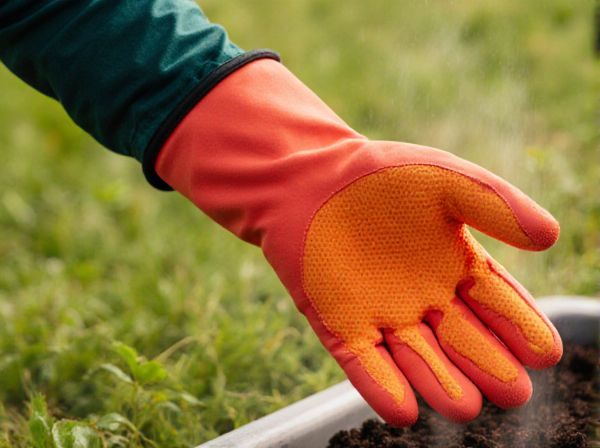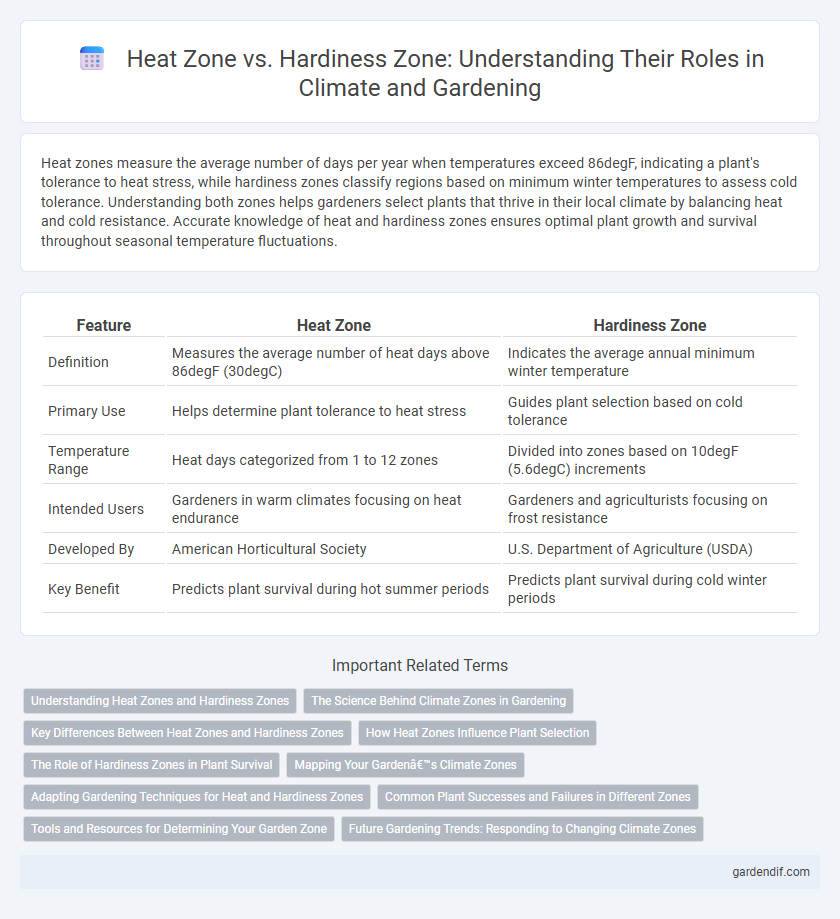
Heat zone vs Hardiness zone Illustration
Heat zones measure the average number of days per year when temperatures exceed 86degF, indicating a plant's tolerance to heat stress, while hardiness zones classify regions based on minimum winter temperatures to assess cold tolerance. Understanding both zones helps gardeners select plants that thrive in their local climate by balancing heat and cold resistance. Accurate knowledge of heat and hardiness zones ensures optimal plant growth and survival throughout seasonal temperature fluctuations.
Table of Comparison
| Feature | Heat Zone | Hardiness Zone |
|---|---|---|
| Definition | Measures the average number of heat days above 86degF (30degC) | Indicates the average annual minimum winter temperature |
| Primary Use | Helps determine plant tolerance to heat stress | Guides plant selection based on cold tolerance |
| Temperature Range | Heat days categorized from 1 to 12 zones | Divided into zones based on 10degF (5.6degC) increments |
| Intended Users | Gardeners in warm climates focusing on heat endurance | Gardeners and agriculturists focusing on frost resistance |
| Developed By | American Horticultural Society | U.S. Department of Agriculture (USDA) |
| Key Benefit | Predicts plant survival during hot summer periods | Predicts plant survival during cold winter periods |
Understanding Heat Zones and Hardiness Zones
Heat zones measure the average number of days per year with temperatures above 86degF, helping gardeners select plants that can tolerate high heat stress. Hardiness zones are defined by the minimum winter temperature, guiding plant survival through cold conditions. Understanding both zones allows precise climate adaptation for optimal plant growth and resilience.
The Science Behind Climate Zones in Gardening
Heat zones and hardiness zones are critical scientific frameworks used in gardening to determine the suitability of plants based on temperature tolerance; hardiness zones classify regions by their average annual minimum winter temperatures, while heat zones measure the average number of days above 86degF (30degC). This differentiation is essential because plants not only need protection from cold winter extremes but also require consideration of intense heat periods that affect growth and survival. Understanding these zones helps gardeners select species with optimal climate adaptability, improving plant health and garden success.
Key Differences Between Heat Zones and Hardiness Zones
Heat zones measure the average number of days per year when temperatures exceed 86degF (30degC), indicating a plant's tolerance to heat stress, while hardiness zones categorize regions based on the average minimum winter temperature, showing cold tolerance. Heat zones range from 1 (less than one day over 86degF) to 12 (more than 210 days), focusing on summer heat impact. Hardiness zones, defined by the USDA, range from 1 (coldest) to 13 (warmest), guiding gardeners on plant survival during winter freezes.
How Heat Zones Influence Plant Selection
Heat zones measure the number of days a region experiences temperatures above 86degF, directly affecting plant survival and growth. Plants suited for specific heat zones can endure high-temperature stress, preventing issues like heat damage or reduced flowering. Selecting plants based on heat zones ensures better adaptation to local climate conditions, optimizing garden resilience and productivity.
The Role of Hardiness Zones in Plant Survival
Hardiness zones classify regions based on average annual minimum temperatures, providing critical data for determining which plants can survive winter conditions. This temperature-focused categorization helps gardeners and farmers select species resilient to local cold stress, ensuring plant survival through seasonal extremes. Understanding hardiness zones is essential for optimizing plant health, productivity, and long-term sustainability in varying climates.
Mapping Your Garden’s Climate Zones
Mapping your garden's climate zones involves understanding both heat zones and hardiness zones, which provide crucial data on temperature extremes for plant selection. Heat zones categorize regions based on the number of days exceeding 86degF, indicating heat tolerance requirements, while hardiness zones reflect the minimum winter temperatures plants can survive. Combining USDA Hardiness Zones with the American Horticultural Society Heat Zones creates a comprehensive climate profile to optimize plant growth and garden resilience.
Adapting Gardening Techniques for Heat and Hardiness Zones
Adapting gardening techniques to heat zones and hardiness zones requires selecting plants that thrive within specific temperature ranges and seasonal conditions defined by these zones. Heat zones, based on the average number of days exceeding 86degF, guide choices for heat-tolerant species, while hardiness zones indicate the coldest temperatures plants can endure. Integrating these zone maps enables gardeners to optimize irrigation, mulching, and planting schedules to enhance plant survival and productivity under local climate stresses.
Common Plant Successes and Failures in Different Zones
Heat zones, defined by the American Horticultural Society based on the number of days above 86degF, play a crucial role in determining plant heat tolerance and survival. Hardiness zones, established by the USDA and based on average annual minimum winter temperatures, help predict plant cold tolerance and winter survival rates. Common plant successes in matching zones include heat-tolerant species like Crape Myrtle thriving in Heat Zones 7-12, while cold-sensitive plants like Azaleas often fail outside USDA Zones 6-9 due to winter damage.
Tools and Resources for Determining Your Garden Zone
Gardeners use tools like the USDA Hardiness Zone Map and the American Horticultural Society's Heat Zone Map to identify appropriate plant species based on climate. Online calculators and mobile apps provide precise zone information by analyzing local temperature data, frost dates, and heat frequency. Access to accurate zone determination resources helps optimize plant selection, ensuring garden success and resilience amid changing climate conditions.
Future Gardening Trends: Responding to Changing Climate Zones
Heat zones, measuring the average number of days above 86degF, and hardiness zones, based on minimum winter temperatures, both guide plant selection but reflect different climate stresses. Future gardening trends emphasize integrating these zones to select resilient plants that thrive amid rising temperatures and unpredictable frosts. Adapting to shifting USDA zones and the American Horticultural Society's heat zones will be crucial for sustainable, climate-responsive landscaping.
Heat zone vs Hardiness zone Infographic

 gardendif.com
gardendif.com